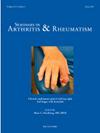传统实验室参数和ifn - γ相关生物标志物在MAS诊断和管理中的应用
IF 4.4
2区 医学
Q1 RHEUMATOLOGY
引用次数: 0
摘要
目的探讨传统实验室参数及ifn γ相关生物标志物白介素-18 (IL-18)、CXCL9和neopterin在Still病(SD)继发巨噬细胞激活综合征(MAS)中的诊断和预后意义。方法入选来自意大利6个中心的41例MAS患者和24例活动性儿童SD患者。在MAS或活性SD的基线(开始或开始特定治疗的48小时内)和T1(距基线5-15天)仅从MAS获得样本。ELISA法检测CXCL9、IL-18、neopterin。MAS临床严重程度评分(MCSS)用于定义MAS严重程度(轻度:0-4分;重度:5-8分)。结果除了2016年MAS标准中包含的参数外,淋巴细胞减少和LDH升高可以可靠地区分MAS和活动性SD。CXCL9、IL-18和neopterin水平能有效区分MAS和活性SD。基线时三种ifn γ相关生物标志物的较高水平与严重的MAS病程相关(MCSS>4)。将CXCL9的基线水平与铁蛋白、血小板计数、纤维蛋白原和LDH的基线水平相结合,对严重MAS的预后评分敏感性为100%,特异性为74%。偶发分析显示T1时CXCL9 >;830 pg/ml和IL-18 >;83,000 pg/ml在≤2个月内无法实现MAS缓解的风险显著(优势比分别为9.3和5.4)。结论在临床实践中,CXCL9检测在支持MAS患者的诊断和指导治疗管理方面具有潜在的作用。本文章由计算机程序翻译,如有差异,请以英文原文为准。
Traditional laboratory parameters and IFNγ-related biomarkers in the diagnosis and management of MAS
Objectives
To evaluate diagnostic and prognostic significance of traditional laboratory parameters of hyperinflammation and of the IFNγ-related biomarkers interleukin-18 (IL-18), CXCL9 and neopterin in macrophage activation syndrome (MAS) secondary to Still’s disease (SD).
Methods
Forty-one patients with MAS and 24 patients with active pediatric SD from six Italian centers were enrolled. Samples were obtained at baseline (at initiation or within 48 hours of initiation of specific treatments) for MAS or active SD and at T1 (5-15 days from baseline) only from MAS. CXCL9, IL-18 and neopterin were measured by ELISA. The MAS clinical severity score (MCSS) was developed to define MAS severity (mild: score 0-4; severe: score 5-8).
Results
In addition to the parameters included in the 2016 MAS criteria, lymphopenia and increased LDH reliably discriminated MAS from active SD. Levels of CXCL9, IL-18 and neopterin effectively discriminated MAS from active SD. Higher levels of the three IFNγ-related biomarkers at baseline were associated with a severe course MAS (MCSS>4). Combining levels at baseline of CXCL9 with those of ferritin, platelet count, fibrinogen and LDH, led to a prognostic score with sensitivity of 100 % and specificity of 74 % for severe MAS. Contingency analysis showed that CXCL9 >830 pg/ml and IL-18 >83,000 pg/ml at T1 had a significant risk of failing to achieve MAS remission in ≤2 months (odds ratio 9.3 and 5.4, respectively).
Conclusions
These findings highlight the potential role of CXCL9 measurement in supporting the diagnosis and guiding the therapeutic management of patients with MAS in clinical practice.
求助全文
通过发布文献求助,成功后即可免费获取论文全文。
去求助
来源期刊
CiteScore
9.20
自引率
4.00%
发文量
176
审稿时长
46 days
期刊介绍:
Seminars in Arthritis and Rheumatism provides access to the highest-quality clinical, therapeutic and translational research about arthritis, rheumatology and musculoskeletal disorders that affect the joints and connective tissue. Each bimonthly issue includes articles giving you the latest diagnostic criteria, consensus statements, systematic reviews and meta-analyses as well as clinical and translational research studies. Read this journal for the latest groundbreaking research and to gain insights from scientists and clinicians on the management and treatment of musculoskeletal and autoimmune rheumatologic diseases. The journal is of interest to rheumatologists, orthopedic surgeons, internal medicine physicians, immunologists and specialists in bone and mineral metabolism.

 求助内容:
求助内容: 应助结果提醒方式:
应助结果提醒方式:


